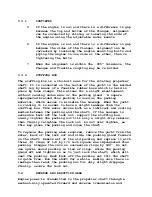
4.1.2
BATTERY CONDITION INDICATOR
This type or "indicator" or "meter" is technically referred to
as a "Suppressed Zero Voltmeter". Note that calibrations do not
start at zero but provide a full-scale reading from 8 or 10 to
16 volts, depending on the meter. Below 8 or 10 volts the
battery charge is so low that terminal voltage readings are
meaningless. Approximate voltage range interpretations are as
follows:
Engine Not ) Bellow 11 ------- Very low battery charge
Running or ) 11-12 ------------ Low battery charge
At idle ) 12-13 ------------ Well charged battery
Engine ) 13 to 13 1/2 ----- Low charge rate
Running ) 13 1/2 to 15 1/2 - Alternator & Voltage
Above ) Regulator OK
Idle ) 15 ½ or above - Voltage. Regulator out of
Adjustment
It is important for you to understand that the reading on the
Battery Condition Indicator Dial is indexed from the toggle test
switch position regardless or the master switch position unless
it is in the "BOTH" position. When the Master Switch is in the
"BOTH" position, the Battery Condition Indicator Dial will
indicate the potential or the highest charged battery no matter
which way the toggle test switch is indexed. When the Master
Switch is in either the "OFF", "BAT 1 " or "BAT 2" positions,
the meter will read the condition of the battery towards which
you index the Toggle Test Switch. Note that panel and meter
illumination, is also provided by this same Toggle Test switch.
Before activating the electrical system, check the condition of
both batteries and then select the strongest battery for engine
starting. Index the Master Switch to the strong battery and then
start your engine. It will usually require about 15 or 30
minutes of engine running time to bring the starting battery
back up to normal charge. Check the Battery Condition Indicator
to assure that charging is normal and when the selected starting
battery has been restored it may be placed on reserve by
switching to the other battery so subsequent charging and
accessory loads will be confined to this second "battery". It is
a good practice to bring the first selected battery up to full
charge before putting it on reserve and changing to the second
battery.
Use the Master switch in 'BOTH" position only for emergency
starting when both batteries are low, or for “top off” charging
when both batteries are near full charge. When both batteries
are completely charged, transfer to either battery, keeping one
battery in reserve.
Never move the Master Switch to “OFF" while the engine is
running or the alternator diodes may be burned out.
Summary of Contents for 299
Page 1: ......
Page 2: ......
Page 53: ......
Page 54: ......
Page 55: ......
Page 56: ......
Page 57: ......
Page 58: ......
Page 59: ......
Page 60: ......
Page 61: ......
Page 62: ......
Page 63: ......
Page 64: ......
Page 65: ......
Page 66: ......
Page 67: ......
Page 68: ......
Page 69: ......
Page 70: ......
Page 71: ......
Page 72: ......
















































